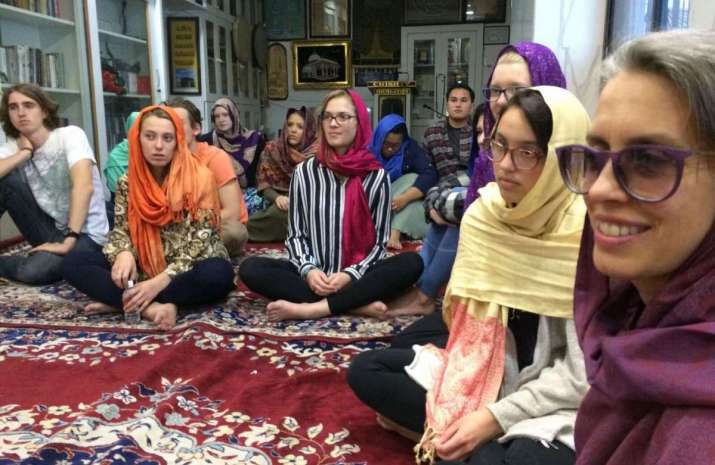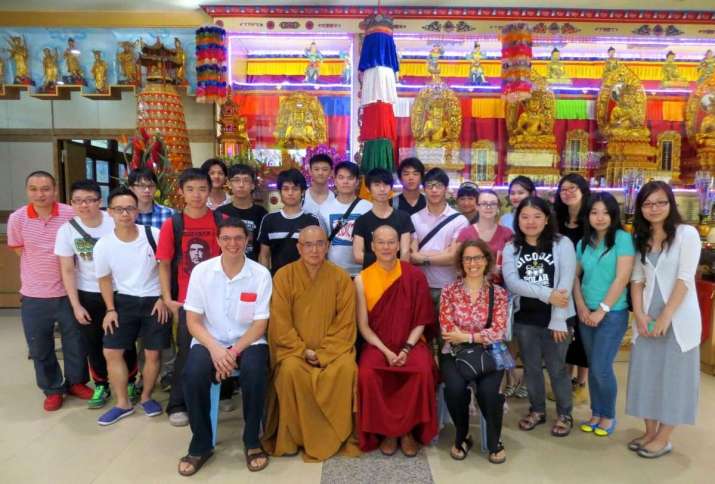
The place of women in Buddhism has long been of interest to scholars, but it has also been relegated to the margins of academic study. IIsaline Blew Horner, a pioneer and early leading scholar of Indian and Pali literature, drew attention to women in early Buddhism in 1930, a shift in focus that has since shaped a significant part of Buddhist scholarship. Pascale Engelmajer, associate professor of religious studies at Carroll University, is among a new generation of feminist Buddhist thinkers who is helping develop the field in new directions.
As Buddhism enters into a greater modern and post-modern world in which long-standing gender norms are brought into question, this work promises to extend beyond academia and into the lives of practitioners. Men, women, and people beyond these categories can better understand their own lives and practices through the complex narratives and metaphors regarding women in Buddhism.
This month I interviewed Pascale Engelmajer about her work and the history of the study of women in Buddhism.
Buddhistdoor Global: What drew you to the topic of women in Pali Buddhism as a focus for your first book?
Pascale Engelmajer: My first book, Women in Pāli Buddhism: Walking the Spiritual Path in Mutual Dependence (Routledge 2014) was a reworking of my doctoral dissertation, which I researched while living in Thailand. The project stemmed mostly from a desire to follow in the footsteps of I. B. Horner’s seminal volume Women Under Primitive Buddhism: Laywomen and Almswomen, which was published in 1930—incidentally by the same publisher that published my book. While there had been a lot of excellent and ground-breaking research on women in Buddhism since Horner’s work, for example, Rita Gross’s Buddhism after Patriarchy (SUNY Press 1993) or Ellison Banks Findly’s Dana: Giving and Getting in Pali Buddhism (Motilal Banarsidass 2003), there was no recent volume-length research focusing specifically on women in the Pali texts.

I also wanted to try to make sense of the contradictions found in the texts, for example the extremely misogynistic descriptions of women and the egalitarian statement of women’s equal ability to reach awakening. Wishing to address these concerns, I started from a place of sympathy toward the Pali texts, but with a critical approach: I assumed that they were coherent and had an internal logic, which I tried to understand. I did not dismiss negative or even misogynistic statements about, or descriptions of, women, but rather I sought to understand what their function is within their wider doctrinal and sociological framework.
BDG: How has the book been received? Any surprising accolades or feedback from scholars or practitioners?
PE: So many books are published these days that one is always surprised that anybody would find time to review them. But, in fact, I was very honored that Rita Gross reviewed it for Buddhist-Christian Studies (Vol. 35, 2015: 229–34) and wrote that “one of the major correctives within Engelmajer’s book is her demonstration that these texts are nowhere nearly as misogynist as some previous commentators have claimed” and further said that my book “strike[s] out into new territory [. . .]—the need to represent the previously unrepresented [and] add[s] significantly to Western ways of discussing early Indian/Pali Buddhism by showing that misogyny and male dominance, which earlier scholars had focused on so much, are not the only story regarding early Buddhism.’” She even added that “it would be useful in more advanced courses in Buddhist studies or gender studies. It should be widely available in libraries.”
This was a nice accolade from one of the pioneers in Buddhist studies and gender. I also had the pleasure of meeting Penny Van Esterik, who recently published The Dance of Nurture: Explaining Breastfeeding (Berghahn 2017), and she was enthusiastic about my book’s descriptions of women’s roles, especially as mothers, and the soteriological value of mothering as it appears in the Pali texts and, which she feels, is well reflected in contemporary practices in the Theravada world.

BDG: In what ways do you think the book has practical relevance to women in Buddhism (and beyond) today?
PE: My hope is that the book, and especially my current work on mothers and mothering, shows that the values and ideals of Buddhism can be fully expressed and put into practice in women’s daily activities which, still today, often focus on caring. What is more, I would like my work to contribute to the realization that mothering values and attitudes are foundational to Buddhism—in fact, they are often used as metaphors to illustrate compassion and loving-kindness. A striking example is that of the well-known Metta Sutta, in which the Buddha enjoins us to “cultivate an unbounded mind toward all beings, and loving-kindness toward all the world . . . just as a mother would protect with her life her own [child], her only [child].”
I worry that, as feminist scholars, we too often reproduce the existing power structures and seek to take our rightful place within them, rather than challenge them drastically. One way of doing this in Buddhist studies is to challenge the mostly androcentric reading of the texts and practices, and to provide new lenses, new approaches that recognize the value and worth of more embodied, more engaged, and more caring scholarship. An inspiring example of this type of scholarship is Karen Derris’s article “Interpreting Buddhist Representations of Motherhood and Mothering” (Journal of Feminist Studies in Religion 30.2, 2014, 61–79), in which she shows that we scholars often work from unacknowledged biases that prevent us from interpreting texts creatively and, particularly, from a truly feminist standpoint.
As a radical feminist scholar, I seek to identify and challenge these biases and to show that women’s work, especially as mothers (biological or functional), is not only recognized as valuable and spiritually meaningful, but also that the values that inform maternal work and thinking (to use Sara Ruddick’s phrase in her critical Maternal Thinking: Towards a Politics of Peace, Beacon Press, 1989) may serve as a radical way of thinking about Buddhism and Buddhist institutions.
References
Rita M. Gross “Review of Women in Pāli Buddhism: Walking the Spiritual Paths in Mutual Dependence” by Pascale Engelmajer, London, Routledge: 2015. 137 pp. in Buddhist-Christian Studies, Vol. 35, 2015: 229–34














